Business Environment Report: Factors Impacting Business Activities
VerifiedAdded on 2020/06/04
|10
|2893
|41
Report
AI Summary
This report provides an in-depth analysis of the business environment, focusing on two contrasting businesses: Tesco and Oxfam. It begins with an introduction to the key factors influencing the business environment, followed by a detailed description of the businesses' types, purposes, and ownership structures. The report examines stakeholder influence, organizational structures, and how these structures help fulfill the businesses' purposes. It then explores the impact of different economic environments, such as growth and recession, on business activities. Furthermore, it includes a PESTLE analysis, considering political, economic, social, technological, legal, and environmental factors affecting the businesses. The report concludes with a comprehensive overview of the external factors impacting the business activities. This report is ideal for students seeking insights into business operations and environmental analysis.
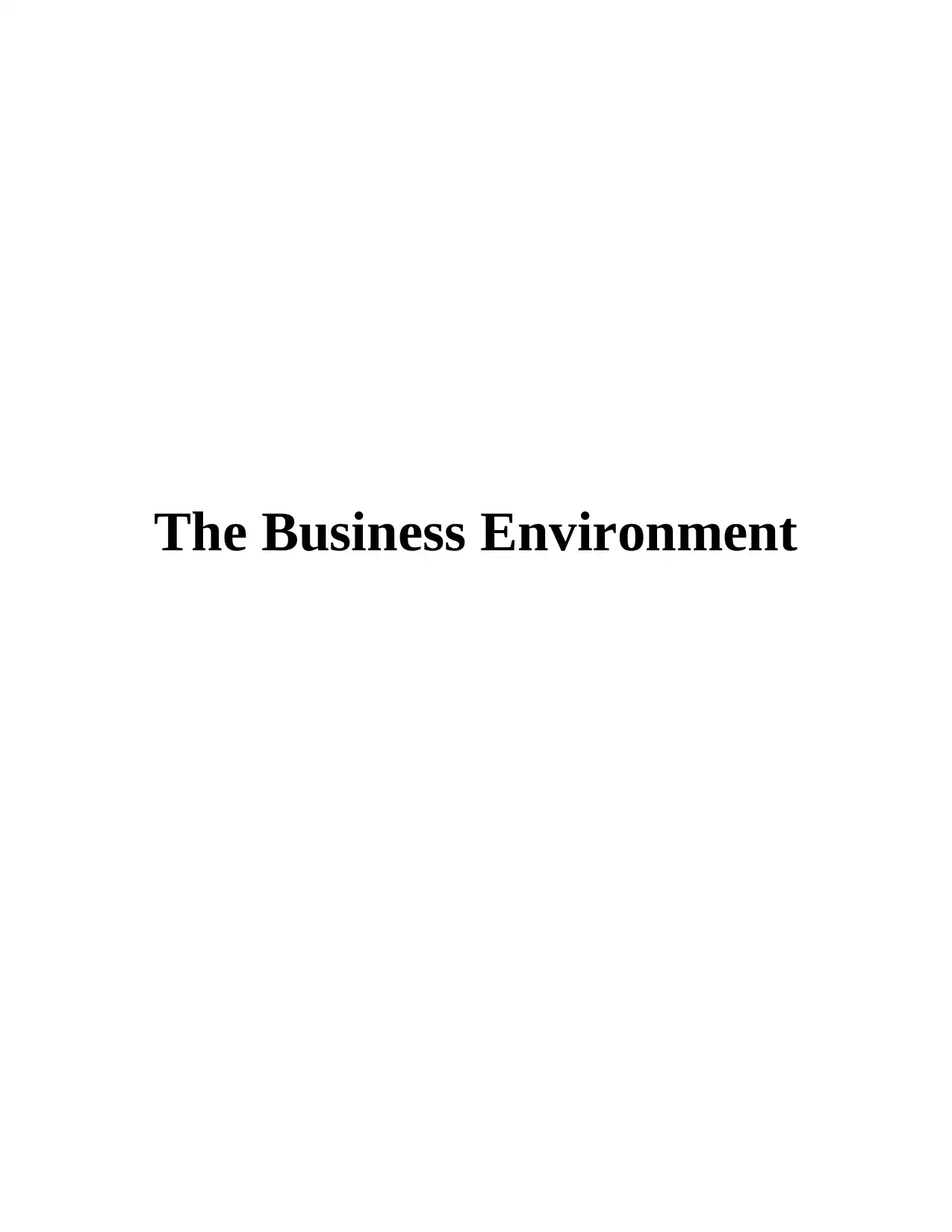
The Business Environment
Paraphrase This Document
Need a fresh take? Get an instant paraphrase of this document with our AI Paraphraser
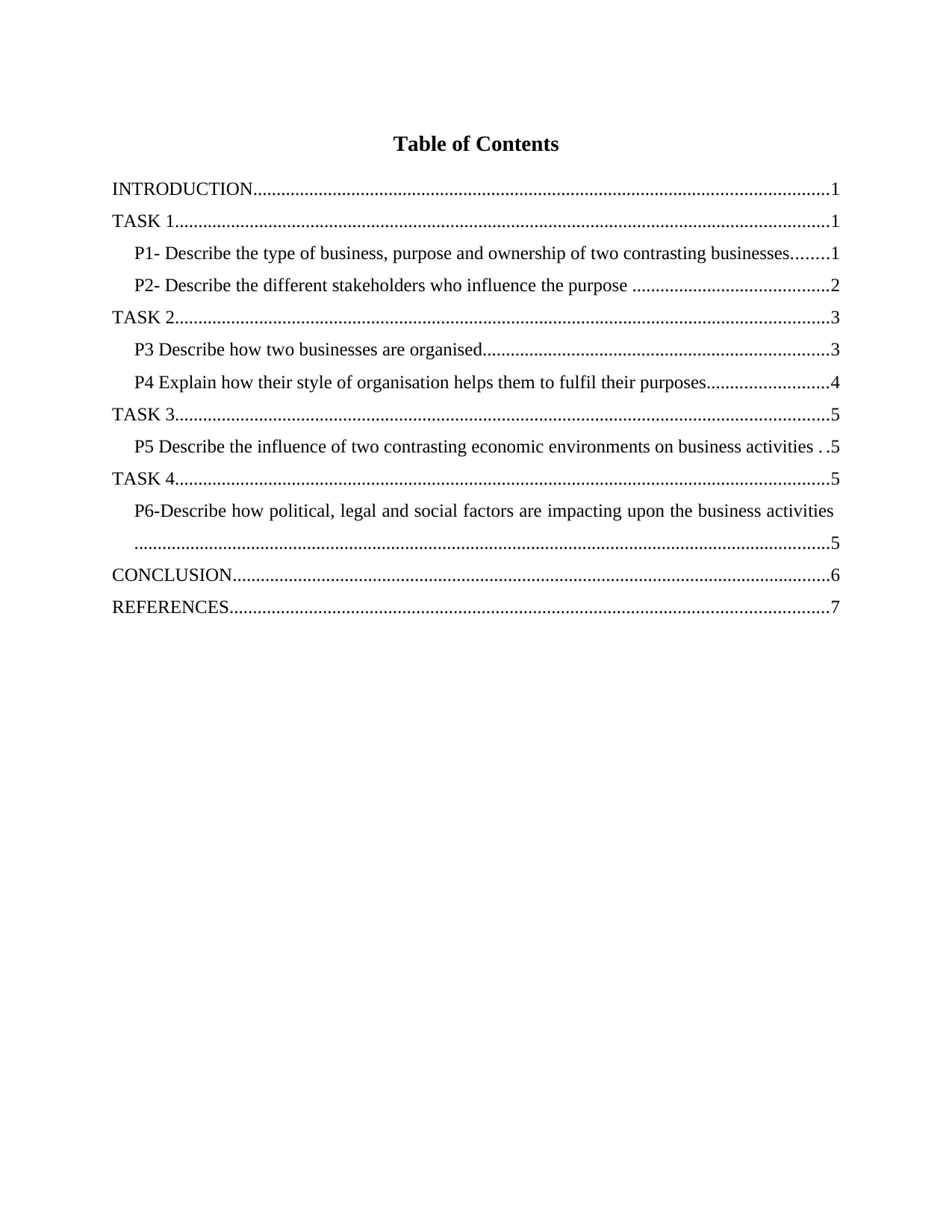
Table of Contents
INTRODUCTION...........................................................................................................................1
TASK 1............................................................................................................................................1
P1- Describe the type of business, purpose and ownership of two contrasting businesses........1
P2- Describe the different stakeholders who influence the purpose ..........................................2
TASK 2............................................................................................................................................3
P3 Describe how two businesses are organised..........................................................................3
P4 Explain how their style of organisation helps them to fulfil their purposes..........................4
TASK 3............................................................................................................................................5
P5 Describe the influence of two contrasting economic environments on business activities . .5
TASK 4............................................................................................................................................5
P6-Describe how political, legal and social factors are impacting upon the business activities
.....................................................................................................................................................5
CONCLUSION................................................................................................................................6
REFERENCES................................................................................................................................7
INTRODUCTION...........................................................................................................................1
TASK 1............................................................................................................................................1
P1- Describe the type of business, purpose and ownership of two contrasting businesses........1
P2- Describe the different stakeholders who influence the purpose ..........................................2
TASK 2............................................................................................................................................3
P3 Describe how two businesses are organised..........................................................................3
P4 Explain how their style of organisation helps them to fulfil their purposes..........................4
TASK 3............................................................................................................................................5
P5 Describe the influence of two contrasting economic environments on business activities . .5
TASK 4............................................................................................................................................5
P6-Describe how political, legal and social factors are impacting upon the business activities
.....................................................................................................................................................5
CONCLUSION................................................................................................................................6
REFERENCES................................................................................................................................7
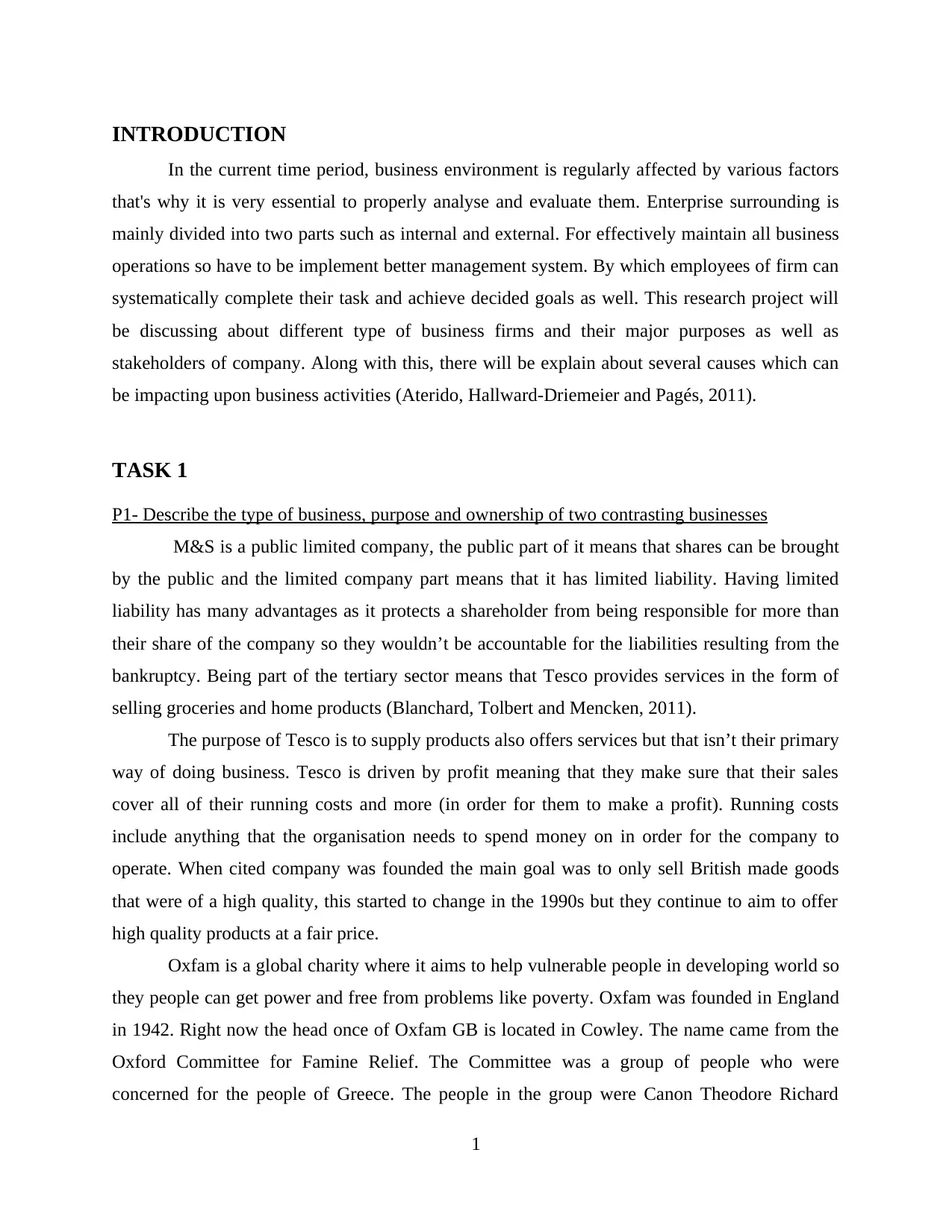
INTRODUCTION
In the current time period, business environment is regularly affected by various factors
that's why it is very essential to properly analyse and evaluate them. Enterprise surrounding is
mainly divided into two parts such as internal and external. For effectively maintain all business
operations so have to be implement better management system. By which employees of firm can
systematically complete their task and achieve decided goals as well. This research project will
be discussing about different type of business firms and their major purposes as well as
stakeholders of company. Along with this, there will be explain about several causes which can
be impacting upon business activities (Aterido, Hallward-Driemeier and Pagés, 2011).
TASK 1
P1- Describe the type of business, purpose and ownership of two contrasting businesses
M&S is a public limited company, the public part of it means that shares can be brought
by the public and the limited company part means that it has limited liability. Having limited
liability has many advantages as it protects a shareholder from being responsible for more than
their share of the company so they wouldn’t be accountable for the liabilities resulting from the
bankruptcy. Being part of the tertiary sector means that Tesco provides services in the form of
selling groceries and home products (Blanchard, Tolbert and Mencken, 2011).
The purpose of Tesco is to supply products also offers services but that isn’t their primary
way of doing business. Tesco is driven by profit meaning that they make sure that their sales
cover all of their running costs and more (in order for them to make a profit). Running costs
include anything that the organisation needs to spend money on in order for the company to
operate. When cited company was founded the main goal was to only sell British made goods
that were of a high quality, this started to change in the 1990s but they continue to aim to offer
high quality products at a fair price.
Oxfam is a global charity where it aims to help vulnerable people in developing world so
they people can get power and free from problems like poverty. Oxfam was founded in England
in 1942. Right now the head once of Oxfam GB is located in Cowley. The name came from the
Oxford Committee for Famine Relief. The Committee was a group of people who were
concerned for the people of Greece. The people in the group were Canon Theodore Richard
1
In the current time period, business environment is regularly affected by various factors
that's why it is very essential to properly analyse and evaluate them. Enterprise surrounding is
mainly divided into two parts such as internal and external. For effectively maintain all business
operations so have to be implement better management system. By which employees of firm can
systematically complete their task and achieve decided goals as well. This research project will
be discussing about different type of business firms and their major purposes as well as
stakeholders of company. Along with this, there will be explain about several causes which can
be impacting upon business activities (Aterido, Hallward-Driemeier and Pagés, 2011).
TASK 1
P1- Describe the type of business, purpose and ownership of two contrasting businesses
M&S is a public limited company, the public part of it means that shares can be brought
by the public and the limited company part means that it has limited liability. Having limited
liability has many advantages as it protects a shareholder from being responsible for more than
their share of the company so they wouldn’t be accountable for the liabilities resulting from the
bankruptcy. Being part of the tertiary sector means that Tesco provides services in the form of
selling groceries and home products (Blanchard, Tolbert and Mencken, 2011).
The purpose of Tesco is to supply products also offers services but that isn’t their primary
way of doing business. Tesco is driven by profit meaning that they make sure that their sales
cover all of their running costs and more (in order for them to make a profit). Running costs
include anything that the organisation needs to spend money on in order for the company to
operate. When cited company was founded the main goal was to only sell British made goods
that were of a high quality, this started to change in the 1990s but they continue to aim to offer
high quality products at a fair price.
Oxfam is a global charity where it aims to help vulnerable people in developing world so
they people can get power and free from problems like poverty. Oxfam was founded in England
in 1942. Right now the head once of Oxfam GB is located in Cowley. The name came from the
Oxford Committee for Famine Relief. The Committee was a group of people who were
concerned for the people of Greece. The people in the group were Canon Theodore Richard
1
⊘ This is a preview!⊘
Do you want full access?
Subscribe today to unlock all pages.

Trusted by 1+ million students worldwide
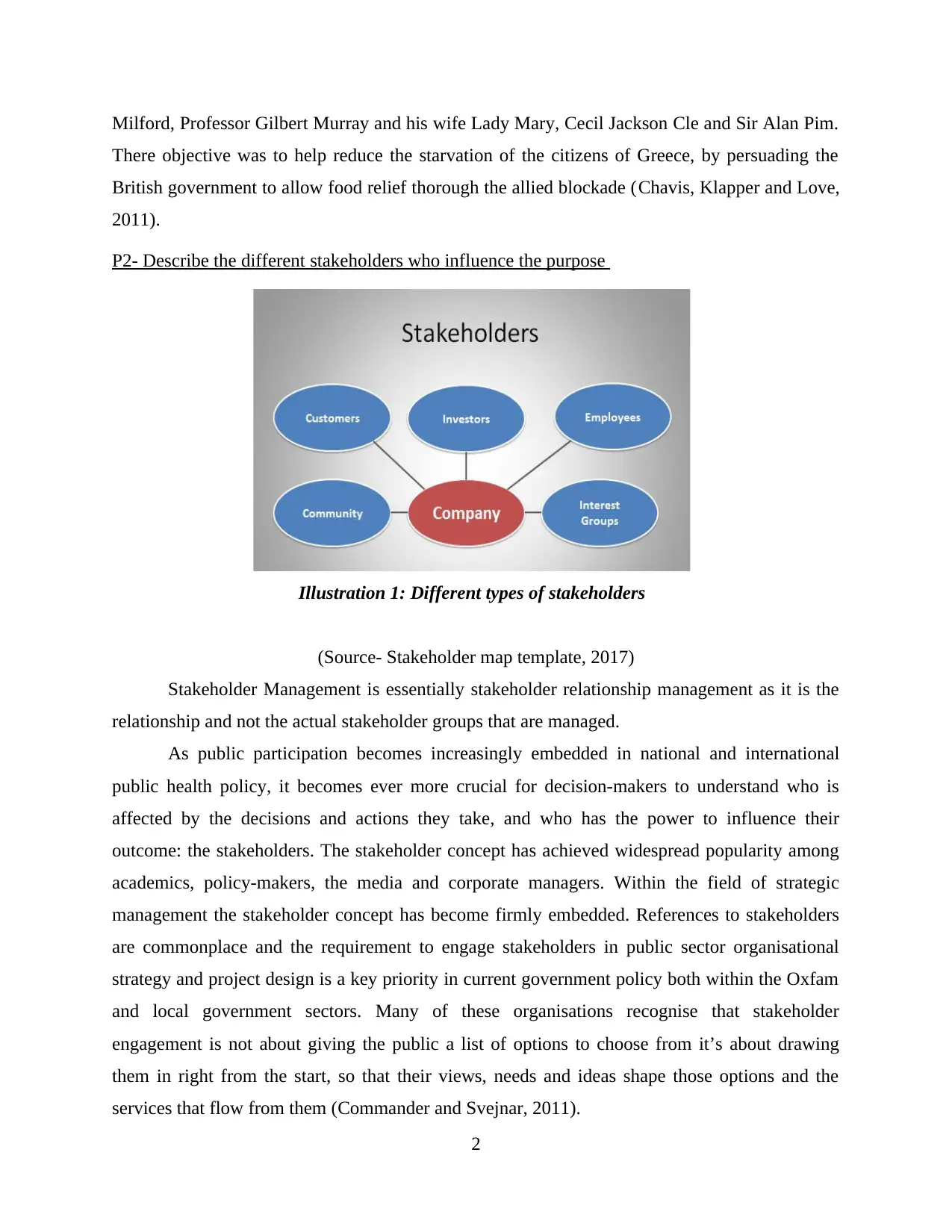
Milford, Professor Gilbert Murray and his wife Lady Mary, Cecil Jackson Cle and Sir Alan Pim.
There objective was to help reduce the starvation of the citizens of Greece, by persuading the
British government to allow food relief thorough the allied blockade (Chavis, Klapper and Love,
2011).
P2- Describe the different stakeholders who influence the purpose
(Source- Stakeholder map template, 2017)
Stakeholder Management is essentially stakeholder relationship management as it is the
relationship and not the actual stakeholder groups that are managed.
As public participation becomes increasingly embedded in national and international
public health policy, it becomes ever more crucial for decision-makers to understand who is
affected by the decisions and actions they take, and who has the power to influence their
outcome: the stakeholders. The stakeholder concept has achieved widespread popularity among
academics, policy-makers, the media and corporate managers. Within the field of strategic
management the stakeholder concept has become firmly embedded. References to stakeholders
are commonplace and the requirement to engage stakeholders in public sector organisational
strategy and project design is a key priority in current government policy both within the Oxfam
and local government sectors. Many of these organisations recognise that stakeholder
engagement is not about giving the public a list of options to choose from it’s about drawing
them in right from the start, so that their views, needs and ideas shape those options and the
services that flow from them (Commander and Svejnar, 2011).
2
Illustration 1: Different types of stakeholders
There objective was to help reduce the starvation of the citizens of Greece, by persuading the
British government to allow food relief thorough the allied blockade (Chavis, Klapper and Love,
2011).
P2- Describe the different stakeholders who influence the purpose
(Source- Stakeholder map template, 2017)
Stakeholder Management is essentially stakeholder relationship management as it is the
relationship and not the actual stakeholder groups that are managed.
As public participation becomes increasingly embedded in national and international
public health policy, it becomes ever more crucial for decision-makers to understand who is
affected by the decisions and actions they take, and who has the power to influence their
outcome: the stakeholders. The stakeholder concept has achieved widespread popularity among
academics, policy-makers, the media and corporate managers. Within the field of strategic
management the stakeholder concept has become firmly embedded. References to stakeholders
are commonplace and the requirement to engage stakeholders in public sector organisational
strategy and project design is a key priority in current government policy both within the Oxfam
and local government sectors. Many of these organisations recognise that stakeholder
engagement is not about giving the public a list of options to choose from it’s about drawing
them in right from the start, so that their views, needs and ideas shape those options and the
services that flow from them (Commander and Svejnar, 2011).
2
Illustration 1: Different types of stakeholders
Paraphrase This Document
Need a fresh take? Get an instant paraphrase of this document with our AI Paraphraser
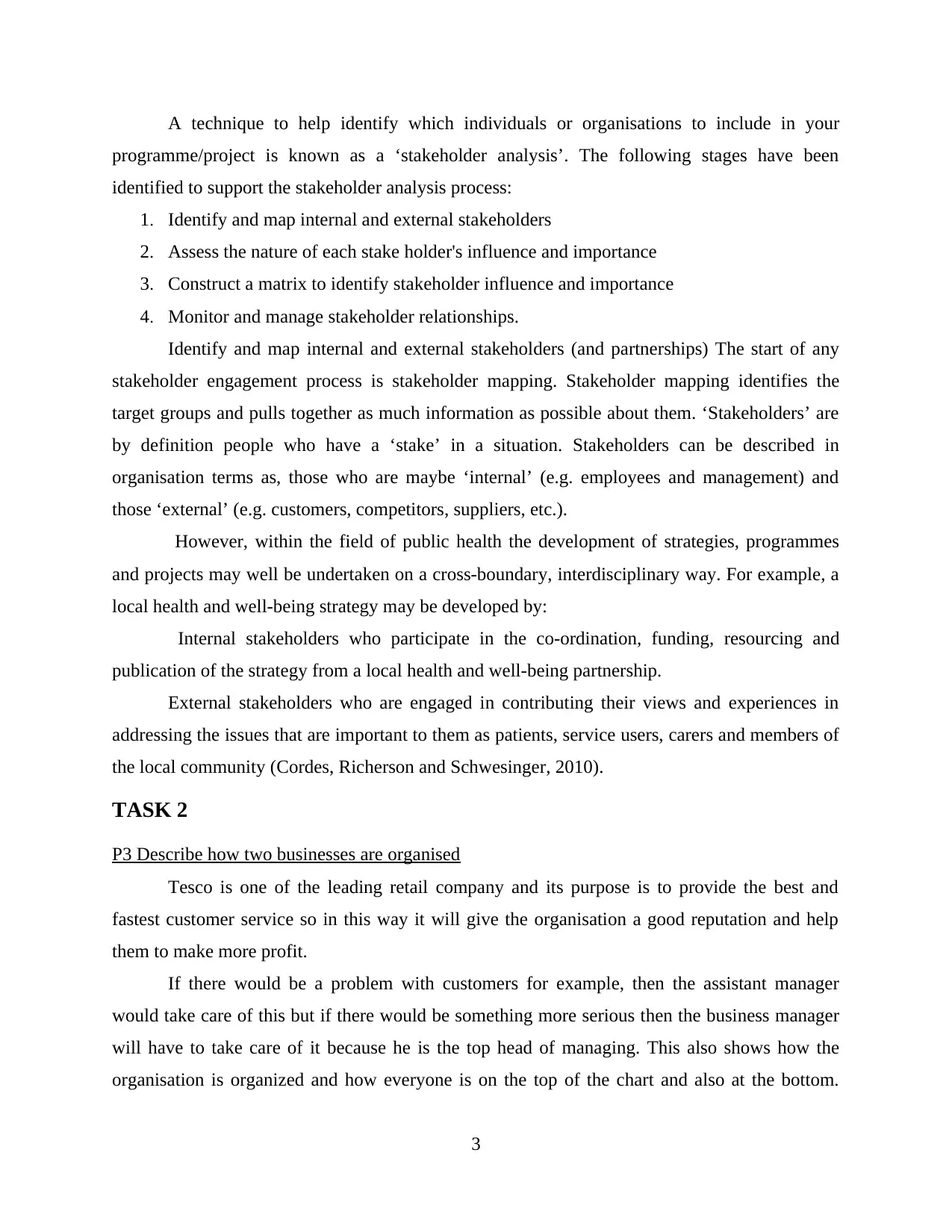
A technique to help identify which individuals or organisations to include in your
programme/project is known as a ‘stakeholder analysis’. The following stages have been
identified to support the stakeholder analysis process:
1. Identify and map internal and external stakeholders
2. Assess the nature of each stake holder's influence and importance
3. Construct a matrix to identify stakeholder influence and importance
4. Monitor and manage stakeholder relationships.
Identify and map internal and external stakeholders (and partnerships) The start of any
stakeholder engagement process is stakeholder mapping. Stakeholder mapping identifies the
target groups and pulls together as much information as possible about them. ‘Stakeholders’ are
by definition people who have a ‘stake’ in a situation. Stakeholders can be described in
organisation terms as, those who are maybe ‘internal’ (e.g. employees and management) and
those ‘external’ (e.g. customers, competitors, suppliers, etc.).
However, within the field of public health the development of strategies, programmes
and projects may well be undertaken on a cross-boundary, interdisciplinary way. For example, a
local health and well-being strategy may be developed by:
Internal stakeholders who participate in the co-ordination, funding, resourcing and
publication of the strategy from a local health and well-being partnership.
External stakeholders who are engaged in contributing their views and experiences in
addressing the issues that are important to them as patients, service users, carers and members of
the local community (Cordes, Richerson and Schwesinger, 2010).
TASK 2
P3 Describe how two businesses are organised
Tesco is one of the leading retail company and its purpose is to provide the best and
fastest customer service so in this way it will give the organisation a good reputation and help
them to make more profit.
If there would be a problem with customers for example, then the assistant manager
would take care of this but if there would be something more serious then the business manager
will have to take care of it because he is the top head of managing. This also shows how the
organisation is organized and how everyone is on the top of the chart and also at the bottom.
3
programme/project is known as a ‘stakeholder analysis’. The following stages have been
identified to support the stakeholder analysis process:
1. Identify and map internal and external stakeholders
2. Assess the nature of each stake holder's influence and importance
3. Construct a matrix to identify stakeholder influence and importance
4. Monitor and manage stakeholder relationships.
Identify and map internal and external stakeholders (and partnerships) The start of any
stakeholder engagement process is stakeholder mapping. Stakeholder mapping identifies the
target groups and pulls together as much information as possible about them. ‘Stakeholders’ are
by definition people who have a ‘stake’ in a situation. Stakeholders can be described in
organisation terms as, those who are maybe ‘internal’ (e.g. employees and management) and
those ‘external’ (e.g. customers, competitors, suppliers, etc.).
However, within the field of public health the development of strategies, programmes
and projects may well be undertaken on a cross-boundary, interdisciplinary way. For example, a
local health and well-being strategy may be developed by:
Internal stakeholders who participate in the co-ordination, funding, resourcing and
publication of the strategy from a local health and well-being partnership.
External stakeholders who are engaged in contributing their views and experiences in
addressing the issues that are important to them as patients, service users, carers and members of
the local community (Cordes, Richerson and Schwesinger, 2010).
TASK 2
P3 Describe how two businesses are organised
Tesco is one of the leading retail company and its purpose is to provide the best and
fastest customer service so in this way it will give the organisation a good reputation and help
them to make more profit.
If there would be a problem with customers for example, then the assistant manager
would take care of this but if there would be something more serious then the business manager
will have to take care of it because he is the top head of managing. This also shows how the
organisation is organized and how everyone is on the top of the chart and also at the bottom.
3
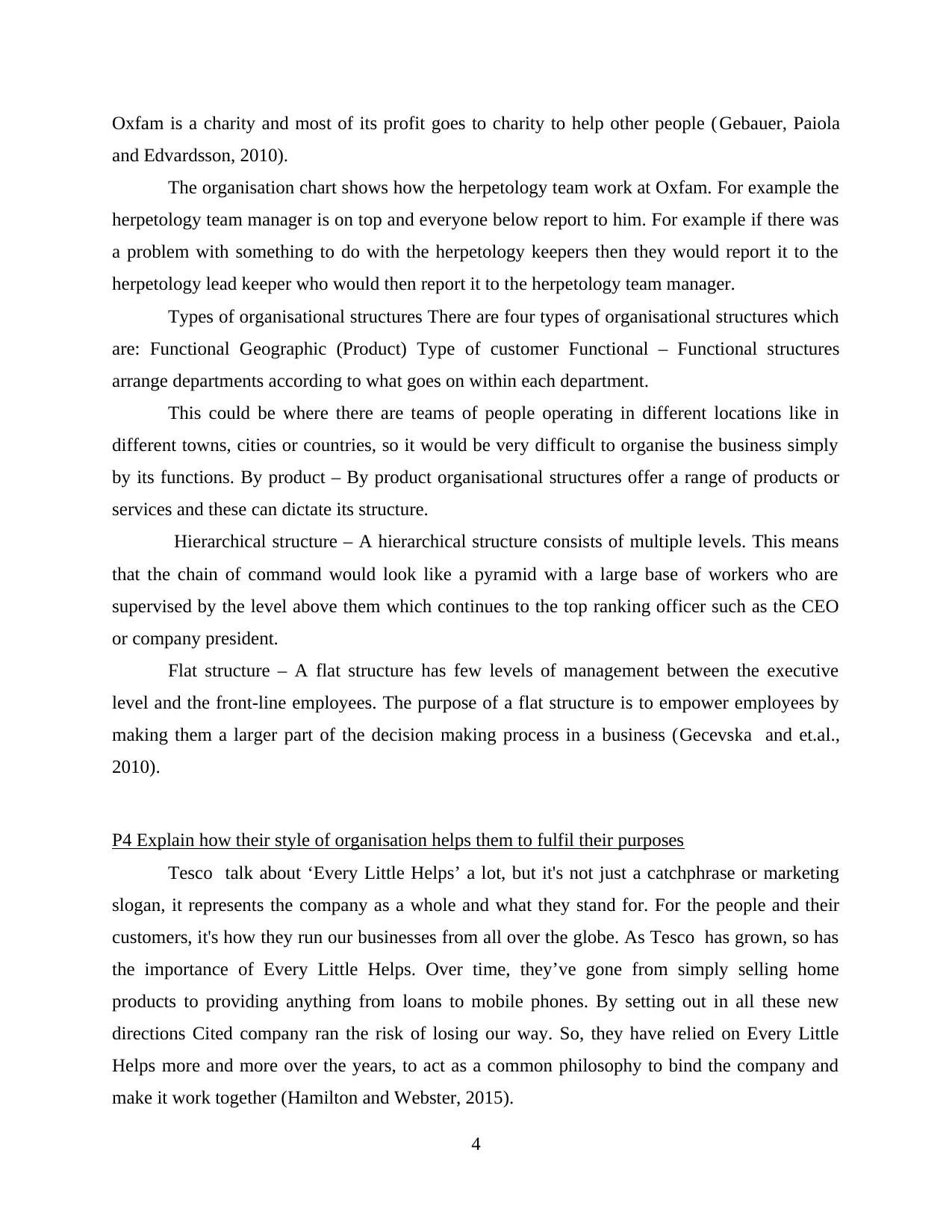
Oxfam is a charity and most of its profit goes to charity to help other people ( Gebauer, Paiola
and Edvardsson, 2010).
The organisation chart shows how the herpetology team work at Oxfam. For example the
herpetology team manager is on top and everyone below report to him. For example if there was
a problem with something to do with the herpetology keepers then they would report it to the
herpetology lead keeper who would then report it to the herpetology team manager.
Types of organisational structures There are four types of organisational structures which
are: Functional Geographic (Product) Type of customer Functional – Functional structures
arrange departments according to what goes on within each department.
This could be where there are teams of people operating in different locations like in
different towns, cities or countries, so it would be very difficult to organise the business simply
by its functions. By product – By product organisational structures offer a range of products or
services and these can dictate its structure.
Hierarchical structure – A hierarchical structure consists of multiple levels. This means
that the chain of command would look like a pyramid with a large base of workers who are
supervised by the level above them which continues to the top ranking officer such as the CEO
or company president.
Flat structure – A flat structure has few levels of management between the executive
level and the front-line employees. The purpose of a flat structure is to empower employees by
making them a larger part of the decision making process in a business (Gecevska and et.al.,
2010).
P4 Explain how their style of organisation helps them to fulfil their purposes
Tesco talk about ‘Every Little Helps’ a lot, but it's not just a catchphrase or marketing
slogan, it represents the company as a whole and what they stand for. For the people and their
customers, it's how they run our businesses from all over the globe. As Tesco has grown, so has
the importance of Every Little Helps. Over time, they’ve gone from simply selling home
products to providing anything from loans to mobile phones. By setting out in all these new
directions Cited company ran the risk of losing our way. So, they have relied on Every Little
Helps more and more over the years, to act as a common philosophy to bind the company and
make it work together (Hamilton and Webster, 2015).
4
and Edvardsson, 2010).
The organisation chart shows how the herpetology team work at Oxfam. For example the
herpetology team manager is on top and everyone below report to him. For example if there was
a problem with something to do with the herpetology keepers then they would report it to the
herpetology lead keeper who would then report it to the herpetology team manager.
Types of organisational structures There are four types of organisational structures which
are: Functional Geographic (Product) Type of customer Functional – Functional structures
arrange departments according to what goes on within each department.
This could be where there are teams of people operating in different locations like in
different towns, cities or countries, so it would be very difficult to organise the business simply
by its functions. By product – By product organisational structures offer a range of products or
services and these can dictate its structure.
Hierarchical structure – A hierarchical structure consists of multiple levels. This means
that the chain of command would look like a pyramid with a large base of workers who are
supervised by the level above them which continues to the top ranking officer such as the CEO
or company president.
Flat structure – A flat structure has few levels of management between the executive
level and the front-line employees. The purpose of a flat structure is to empower employees by
making them a larger part of the decision making process in a business (Gecevska and et.al.,
2010).
P4 Explain how their style of organisation helps them to fulfil their purposes
Tesco talk about ‘Every Little Helps’ a lot, but it's not just a catchphrase or marketing
slogan, it represents the company as a whole and what they stand for. For the people and their
customers, it's how they run our businesses from all over the globe. As Tesco has grown, so has
the importance of Every Little Helps. Over time, they’ve gone from simply selling home
products to providing anything from loans to mobile phones. By setting out in all these new
directions Cited company ran the risk of losing our way. So, they have relied on Every Little
Helps more and more over the years, to act as a common philosophy to bind the company and
make it work together (Hamilton and Webster, 2015).
4
⊘ This is a preview!⊘
Do you want full access?
Subscribe today to unlock all pages.

Trusted by 1+ million students worldwide
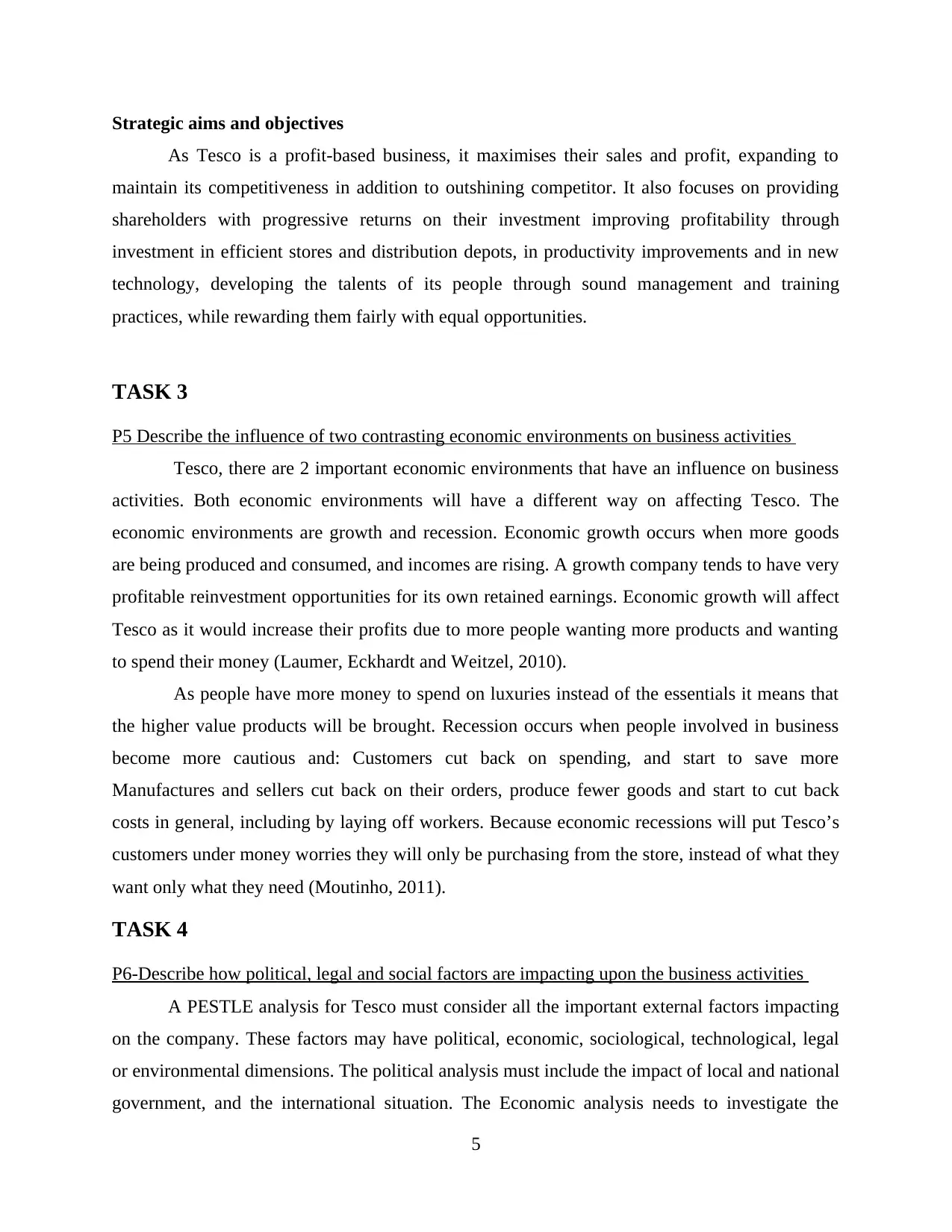
Strategic aims and objectives
As Tesco is a profit-based business, it maximises their sales and profit, expanding to
maintain its competitiveness in addition to outshining competitor. It also focuses on providing
shareholders with progressive returns on their investment improving profitability through
investment in efficient stores and distribution depots, in productivity improvements and in new
technology, developing the talents of its people through sound management and training
practices, while rewarding them fairly with equal opportunities.
TASK 3
P5 Describe the influence of two contrasting economic environments on business activities
Tesco, there are 2 important economic environments that have an influence on business
activities. Both economic environments will have a different way on affecting Tesco. The
economic environments are growth and recession. Economic growth occurs when more goods
are being produced and consumed, and incomes are rising. A growth company tends to have very
profitable reinvestment opportunities for its own retained earnings. Economic growth will affect
Tesco as it would increase their profits due to more people wanting more products and wanting
to spend their money (Laumer, Eckhardt and Weitzel, 2010).
As people have more money to spend on luxuries instead of the essentials it means that
the higher value products will be brought. Recession occurs when people involved in business
become more cautious and: Customers cut back on spending, and start to save more
Manufactures and sellers cut back on their orders, produce fewer goods and start to cut back
costs in general, including by laying off workers. Because economic recessions will put Tesco’s
customers under money worries they will only be purchasing from the store, instead of what they
want only what they need (Moutinho, 2011).
TASK 4
P6-Describe how political, legal and social factors are impacting upon the business activities
A PESTLE analysis for Tesco must consider all the important external factors impacting
on the company. These factors may have political, economic, sociological, technological, legal
or environmental dimensions. The political analysis must include the impact of local and national
government, and the international situation. The Economic analysis needs to investigate the
5
As Tesco is a profit-based business, it maximises their sales and profit, expanding to
maintain its competitiveness in addition to outshining competitor. It also focuses on providing
shareholders with progressive returns on their investment improving profitability through
investment in efficient stores and distribution depots, in productivity improvements and in new
technology, developing the talents of its people through sound management and training
practices, while rewarding them fairly with equal opportunities.
TASK 3
P5 Describe the influence of two contrasting economic environments on business activities
Tesco, there are 2 important economic environments that have an influence on business
activities. Both economic environments will have a different way on affecting Tesco. The
economic environments are growth and recession. Economic growth occurs when more goods
are being produced and consumed, and incomes are rising. A growth company tends to have very
profitable reinvestment opportunities for its own retained earnings. Economic growth will affect
Tesco as it would increase their profits due to more people wanting more products and wanting
to spend their money (Laumer, Eckhardt and Weitzel, 2010).
As people have more money to spend on luxuries instead of the essentials it means that
the higher value products will be brought. Recession occurs when people involved in business
become more cautious and: Customers cut back on spending, and start to save more
Manufactures and sellers cut back on their orders, produce fewer goods and start to cut back
costs in general, including by laying off workers. Because economic recessions will put Tesco’s
customers under money worries they will only be purchasing from the store, instead of what they
want only what they need (Moutinho, 2011).
TASK 4
P6-Describe how political, legal and social factors are impacting upon the business activities
A PESTLE analysis for Tesco must consider all the important external factors impacting
on the company. These factors may have political, economic, sociological, technological, legal
or environmental dimensions. The political analysis must include the impact of local and national
government, and the international situation. The Economic analysis needs to investigate the
5
Paraphrase This Document
Need a fresh take? Get an instant paraphrase of this document with our AI Paraphraser
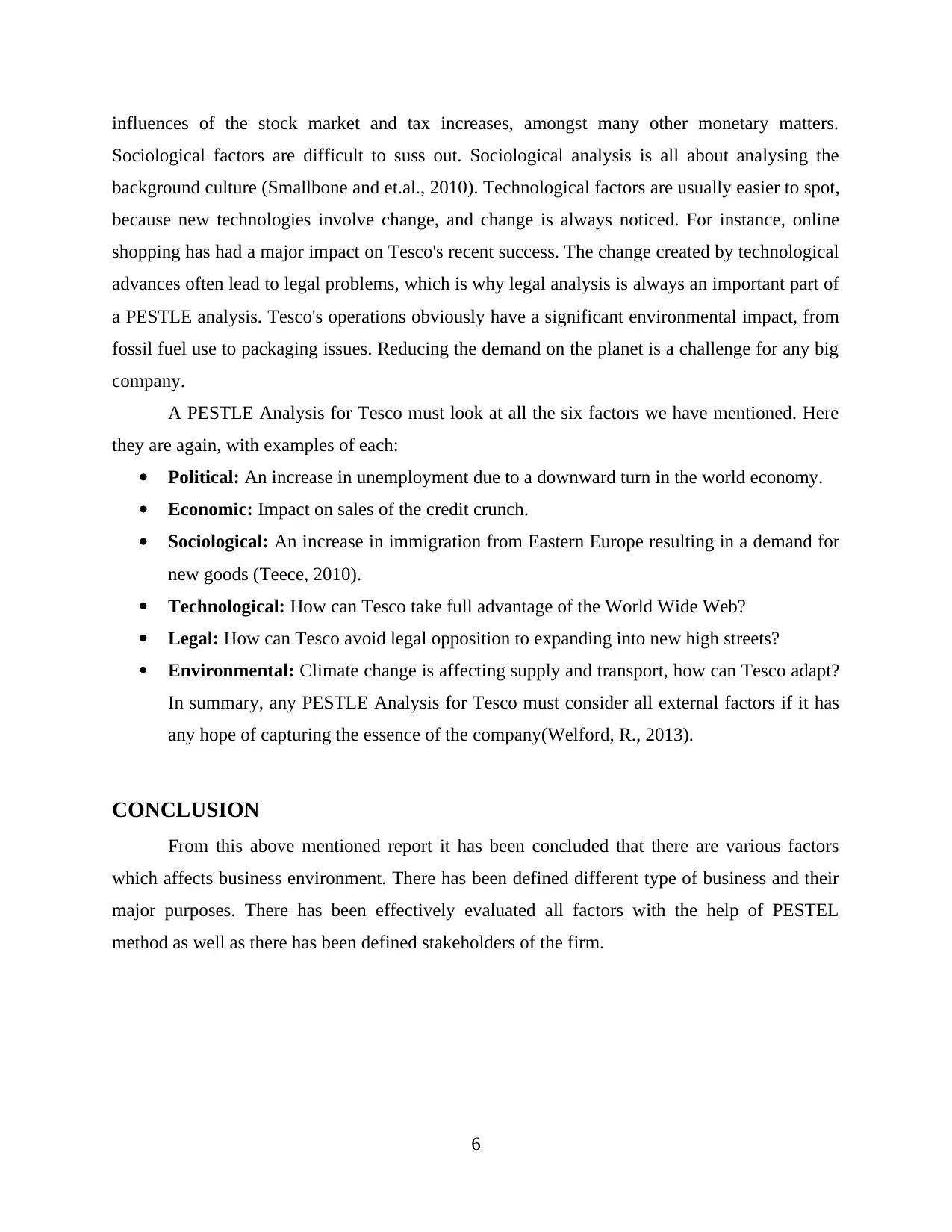
influences of the stock market and tax increases, amongst many other monetary matters.
Sociological factors are difficult to suss out. Sociological analysis is all about analysing the
background culture (Smallbone and et.al., 2010). Technological factors are usually easier to spot,
because new technologies involve change, and change is always noticed. For instance, online
shopping has had a major impact on Tesco's recent success. The change created by technological
advances often lead to legal problems, which is why legal analysis is always an important part of
a PESTLE analysis. Tesco's operations obviously have a significant environmental impact, from
fossil fuel use to packaging issues. Reducing the demand on the planet is a challenge for any big
company.
A PESTLE Analysis for Tesco must look at all the six factors we have mentioned. Here
they are again, with examples of each:
Political: An increase in unemployment due to a downward turn in the world economy.
Economic: Impact on sales of the credit crunch.
Sociological: An increase in immigration from Eastern Europe resulting in a demand for
new goods (Teece, 2010).
Technological: How can Tesco take full advantage of the World Wide Web?
Legal: How can Tesco avoid legal opposition to expanding into new high streets?
Environmental: Climate change is affecting supply and transport, how can Tesco adapt?
In summary, any PESTLE Analysis for Tesco must consider all external factors if it has
any hope of capturing the essence of the company(Welford, R., 2013).
CONCLUSION
From this above mentioned report it has been concluded that there are various factors
which affects business environment. There has been defined different type of business and their
major purposes. There has been effectively evaluated all factors with the help of PESTEL
method as well as there has been defined stakeholders of the firm.
6
Sociological factors are difficult to suss out. Sociological analysis is all about analysing the
background culture (Smallbone and et.al., 2010). Technological factors are usually easier to spot,
because new technologies involve change, and change is always noticed. For instance, online
shopping has had a major impact on Tesco's recent success. The change created by technological
advances often lead to legal problems, which is why legal analysis is always an important part of
a PESTLE analysis. Tesco's operations obviously have a significant environmental impact, from
fossil fuel use to packaging issues. Reducing the demand on the planet is a challenge for any big
company.
A PESTLE Analysis for Tesco must look at all the six factors we have mentioned. Here
they are again, with examples of each:
Political: An increase in unemployment due to a downward turn in the world economy.
Economic: Impact on sales of the credit crunch.
Sociological: An increase in immigration from Eastern Europe resulting in a demand for
new goods (Teece, 2010).
Technological: How can Tesco take full advantage of the World Wide Web?
Legal: How can Tesco avoid legal opposition to expanding into new high streets?
Environmental: Climate change is affecting supply and transport, how can Tesco adapt?
In summary, any PESTLE Analysis for Tesco must consider all external factors if it has
any hope of capturing the essence of the company(Welford, R., 2013).
CONCLUSION
From this above mentioned report it has been concluded that there are various factors
which affects business environment. There has been defined different type of business and their
major purposes. There has been effectively evaluated all factors with the help of PESTEL
method as well as there has been defined stakeholders of the firm.
6
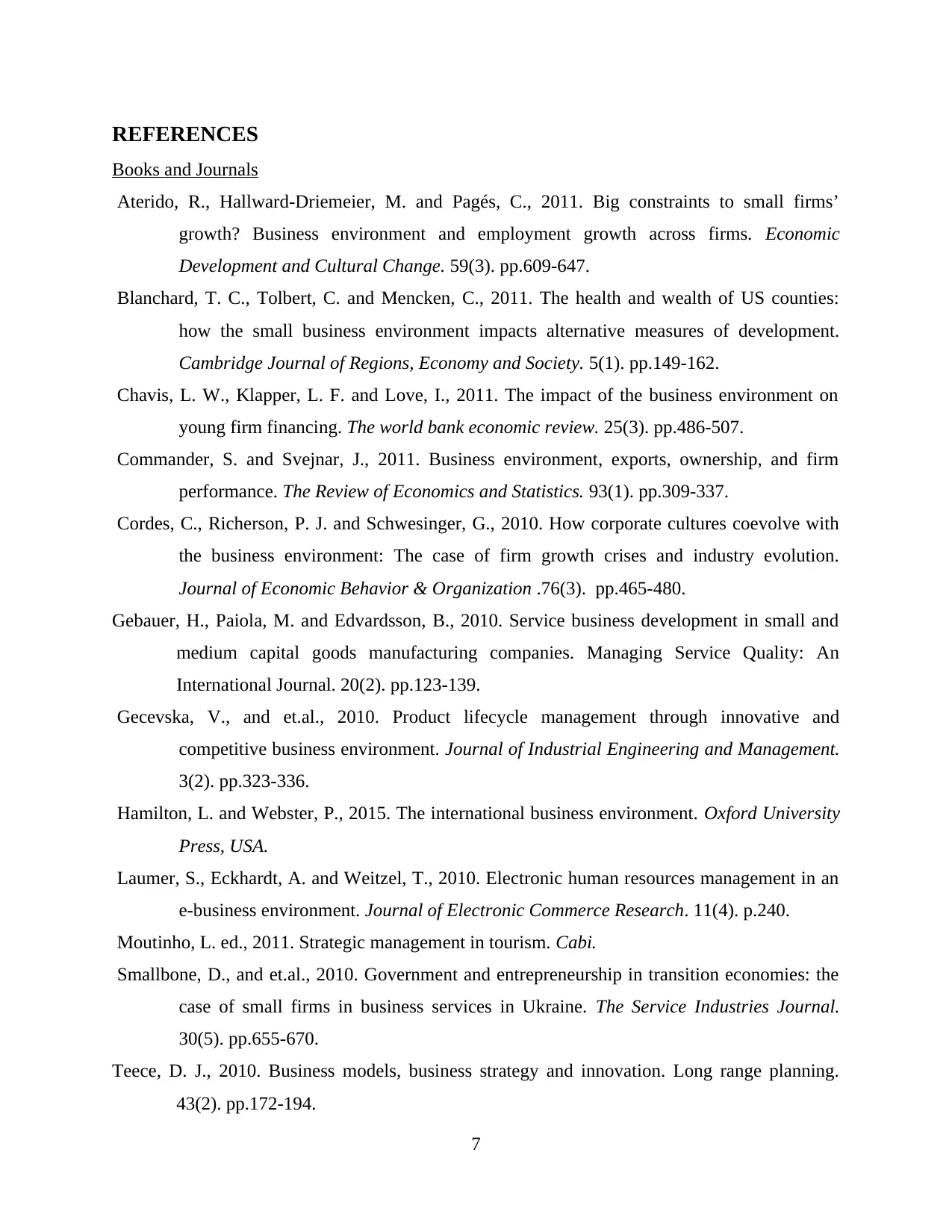
REFERENCES
Books and Journals
Aterido, R., Hallward-Driemeier, M. and Pagés, C., 2011. Big constraints to small firms’
growth? Business environment and employment growth across firms. Economic
Development and Cultural Change. 59(3). pp.609-647.
Blanchard, T. C., Tolbert, C. and Mencken, C., 2011. The health and wealth of US counties:
how the small business environment impacts alternative measures of development.
Cambridge Journal of Regions, Economy and Society. 5(1). pp.149-162.
Chavis, L. W., Klapper, L. F. and Love, I., 2011. The impact of the business environment on
young firm financing. The world bank economic review. 25(3). pp.486-507.
Commander, S. and Svejnar, J., 2011. Business environment, exports, ownership, and firm
performance. The Review of Economics and Statistics. 93(1). pp.309-337.
Cordes, C., Richerson, P. J. and Schwesinger, G., 2010. How corporate cultures coevolve with
the business environment: The case of firm growth crises and industry evolution.
Journal of Economic Behavior & Organization .76(3). pp.465-480.
Gebauer, H., Paiola, M. and Edvardsson, B., 2010. Service business development in small and
medium capital goods manufacturing companies. Managing Service Quality: An
International Journal. 20(2). pp.123-139.
Gecevska, V., and et.al., 2010. Product lifecycle management through innovative and
competitive business environment. Journal of Industrial Engineering and Management.
3(2). pp.323-336.
Hamilton, L. and Webster, P., 2015. The international business environment. Oxford University
Press, USA.
Laumer, S., Eckhardt, A. and Weitzel, T., 2010. Electronic human resources management in an
e-business environment. Journal of Electronic Commerce Research. 11(4). p.240.
Moutinho, L. ed., 2011. Strategic management in tourism. Cabi.
Smallbone, D., and et.al., 2010. Government and entrepreneurship in transition economies: the
case of small firms in business services in Ukraine. The Service Industries Journal.
30(5). pp.655-670.
Teece, D. J., 2010. Business models, business strategy and innovation. Long range planning.
43(2). pp.172-194.
7
Books and Journals
Aterido, R., Hallward-Driemeier, M. and Pagés, C., 2011. Big constraints to small firms’
growth? Business environment and employment growth across firms. Economic
Development and Cultural Change. 59(3). pp.609-647.
Blanchard, T. C., Tolbert, C. and Mencken, C., 2011. The health and wealth of US counties:
how the small business environment impacts alternative measures of development.
Cambridge Journal of Regions, Economy and Society. 5(1). pp.149-162.
Chavis, L. W., Klapper, L. F. and Love, I., 2011. The impact of the business environment on
young firm financing. The world bank economic review. 25(3). pp.486-507.
Commander, S. and Svejnar, J., 2011. Business environment, exports, ownership, and firm
performance. The Review of Economics and Statistics. 93(1). pp.309-337.
Cordes, C., Richerson, P. J. and Schwesinger, G., 2010. How corporate cultures coevolve with
the business environment: The case of firm growth crises and industry evolution.
Journal of Economic Behavior & Organization .76(3). pp.465-480.
Gebauer, H., Paiola, M. and Edvardsson, B., 2010. Service business development in small and
medium capital goods manufacturing companies. Managing Service Quality: An
International Journal. 20(2). pp.123-139.
Gecevska, V., and et.al., 2010. Product lifecycle management through innovative and
competitive business environment. Journal of Industrial Engineering and Management.
3(2). pp.323-336.
Hamilton, L. and Webster, P., 2015. The international business environment. Oxford University
Press, USA.
Laumer, S., Eckhardt, A. and Weitzel, T., 2010. Electronic human resources management in an
e-business environment. Journal of Electronic Commerce Research. 11(4). p.240.
Moutinho, L. ed., 2011. Strategic management in tourism. Cabi.
Smallbone, D., and et.al., 2010. Government and entrepreneurship in transition economies: the
case of small firms in business services in Ukraine. The Service Industries Journal.
30(5). pp.655-670.
Teece, D. J., 2010. Business models, business strategy and innovation. Long range planning.
43(2). pp.172-194.
7
⊘ This is a preview!⊘
Do you want full access?
Subscribe today to unlock all pages.

Trusted by 1+ million students worldwide
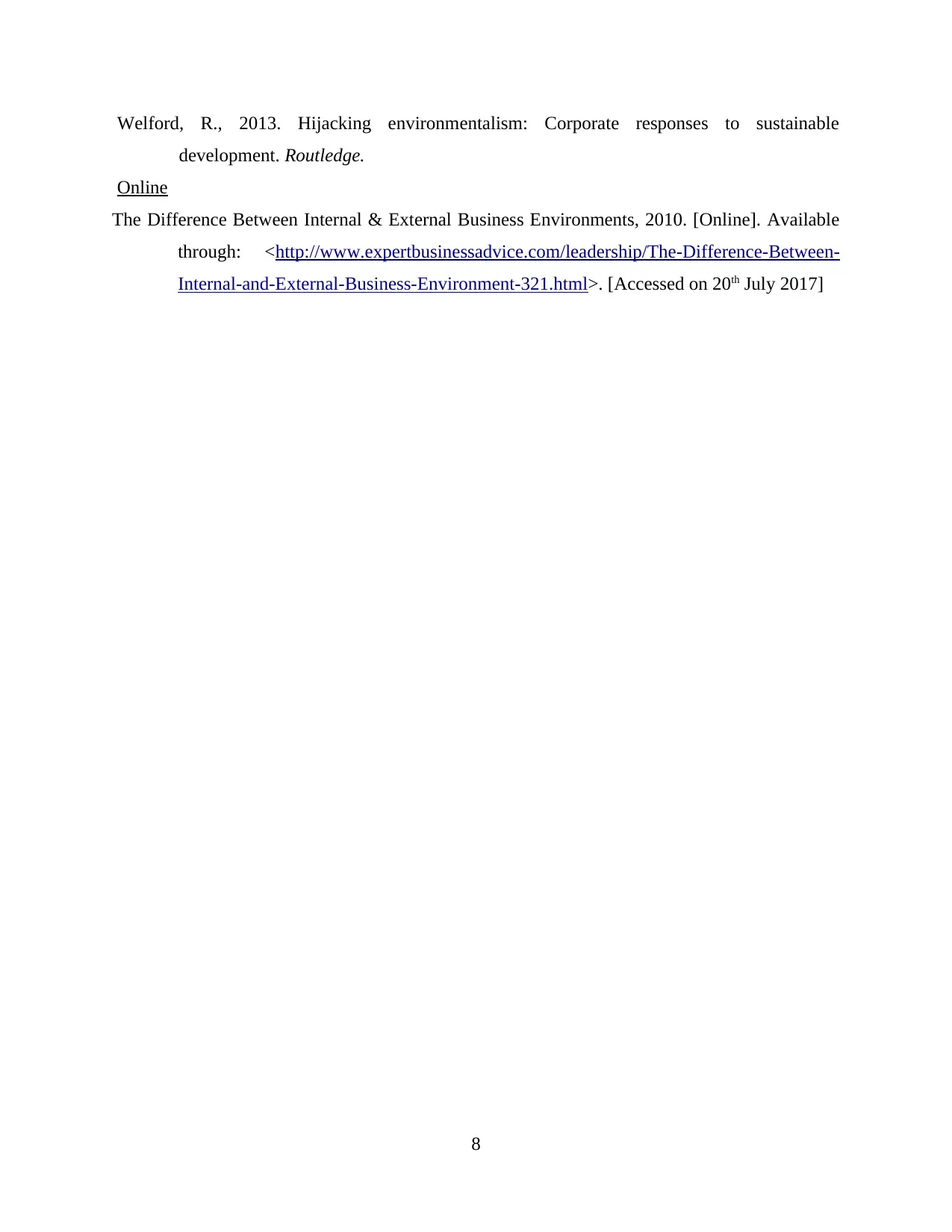
Welford, R., 2013. Hijacking environmentalism: Corporate responses to sustainable
development. Routledge.
Online
The Difference Between Internal & External Business Environments, 2010. [Online]. Available
through: <http://www.expertbusinessadvice.com/leadership/The-Difference-Between-
Internal-and-External-Business-Environment-321.html>. [Accessed on 20th July 2017]
8
development. Routledge.
Online
The Difference Between Internal & External Business Environments, 2010. [Online]. Available
through: <http://www.expertbusinessadvice.com/leadership/The-Difference-Between-
Internal-and-External-Business-Environment-321.html>. [Accessed on 20th July 2017]
8
1 out of 10
Related Documents
Your All-in-One AI-Powered Toolkit for Academic Success.
+13062052269
info@desklib.com
Available 24*7 on WhatsApp / Email
![[object Object]](/_next/static/media/star-bottom.7253800d.svg)
Unlock your academic potential
Copyright © 2020–2025 A2Z Services. All Rights Reserved. Developed and managed by ZUCOL.




